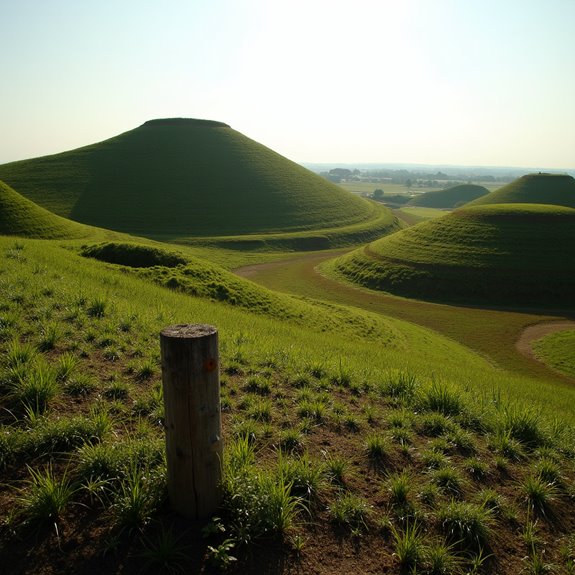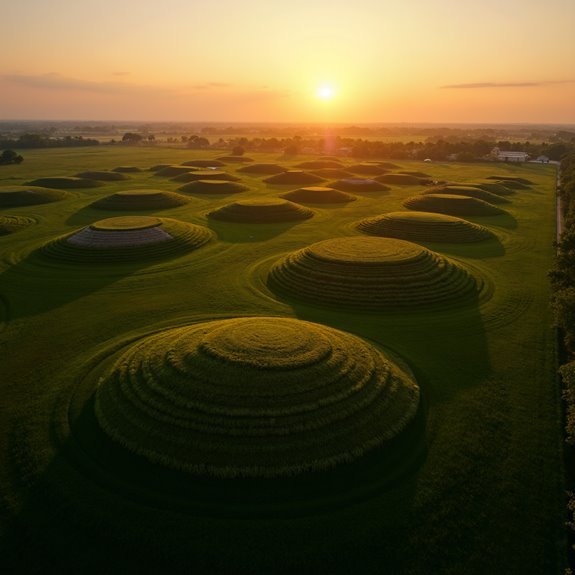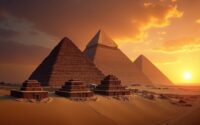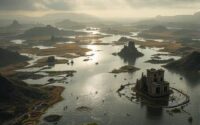What’s Buried Beneath the Mounds of Cahokia?
Beneath the mounds of Cahokia lies a complex history waiting to be uncovered. Archaeologists have discovered evidence of elite burial practices, intricate artifacts, and remnants of a sophisticated society. Each layer of earth reveals stories about the Mississippian people’s culture, beliefs, and social structures. What lies hidden in these ancient structures could reshape our understanding of their civilization and its legacy. The mystery only deepens as more discoveries emerge.
Introduction

Cahokia Mounds stands as one of the most significant archaeological sites in North America, showcasing the remnants of a sophisticated prehistoric Native American city. Established around 600 AD near modern-day St. Louis, Missouri, this vast settlement once covered nearly six square miles and housed thousands of residents. The site features over 100 mounds, each meticulously constructed for various purposes, including ceremonial and residential uses. Its largest mound, Cahokia Mound, rises nearly 100 feet and served as a central hub for the community. Cahokia Mounds not only reflects advanced engineering and social organization but also illustrates the complexity of life for its inhabitants. Today, it’s recognized as a UNESCO World Heritage Site, drawing researchers and visitors enthusiastic to understand its rich history.
Ancient Mississippian Culture Roots

The roots of the ancient Mississippian culture, from which Cahokia Mounds emerged, are deeply intertwined with the agricultural practices and social structures that developed in the Mississippi River Valley. This culture flourished between 800 and 1600 CE, driven by advancements in corn cultivation that supported large, complex societies. Settlements grew into urban centers, showcasing intricate mound-building and vibrant trade networks. Hierarchical social structures emerged, with elites governing and a stratified society forming around them. Religion and cosmology played essential roles, influencing daily life and monumental constructions. The Mississippian people’s ingenuity paved the way for sophisticated arts and crafts, enriching their culture. Overall, these foundational aspects helped shape the iconic Cahokia Mounds and its surrounding community’s legacy.
Notable Cases or Sightings

While exploring the vast landscape of the Cahokia Mounds, one can’t help but encounter notable cases of unusual findings and sightings that highlight the site’s significance. In 1961, archaeologists uncovered a mass grave containing over 250 individuals at Mound 72, suggesting possible burial practices linked to elite individuals. Additionally, visitors often report odd occurrences, such as unexplained noises or sudden temperature drops, adding to the area’s mystique. Some have claimed to see shadowy figures wandering near the mounds, sparking interest in folklore. Artifacts, including shell beads and pottery, have surfaced in various excavations, revealing the rich cultural heritage tied to these ancient mounds. Each discovery invites deeper exploration into Cahokia’s enigmatic past and the community that once thrived there.
Common Theories or Explanations
As researchers explore the mysteries of the Cahokia Mounds, several common theories emerge to explain the site’s historical significance and the civilization that once thrived there. One theory suggests that Cahokia served as a political and religious center, where leaders united diverse tribes under a shared belief system. Another proposes that the mounds functioned as ceremonial sites for rituals, connecting the community to their ancestors. Additionally, some scholars argue that trade routes played a vital role in the site’s growth, allowing for cultural exchange and economic prosperity. Finally, environmental factors, such as fertile land and river access, likely contributed to its development. Together, these theories paint a complex picture of a vibrant society that once flourished in the Cahokia region.
Frequently Asked Questions
How Were the Mounds at Cahokia Constructed?
The mounds at Cahokia were constructed using millions of cubic feet of earth. Workers shaped them over decades, hauling soil with baskets and tools, creating impressive structures that served religious, political, and social purposes for the community.
What Tools Did Ancient Builders Use for Mound Construction?
Ancient builders used simple yet effective tools for mound construction. They employed wooden shovels, baskets for transporting dirt, and digging sticks, showcasing their ingenuity as they formed the impressive structures still visible today at Cahokia.
Are There Records of Burial Practices at Cahokia?
Researchers have found extensive records detailing burial practices at Cahokia. They reveal that individuals were often interred with grave goods, emphasizing the cultural significance and rituals accompanying death in this ancient society.
What Types of Artifacts Have Been Discovered at Cahokia?
Archaeologists have unearthed various artifacts at Cahokia, including pottery, tools, and ceremonial items. These findings reveal insights into the daily lives and spiritual practices of the Mississippian culture that thrived in the region.
How Has Modern Technology Influenced Cahokia’s Archaeological Study?
Modern technology has transformed Cahokia’s archaeological study. Researchers utilize drones and ground-penetrating radar, revealing hidden structures and artifacts. These advancements not only enhance understanding but also allow for more precise excavation techniques, improving historical insights.


